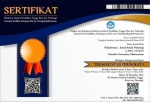Pengaruh Modal Psikologis dan Kesadaran Penuh Terhadap Keseimbangan Kehidupan-Kerja Pada Tenaga Kependidikan Wanita
Abstract
Penelitian ini bertujuan untuk mengetahui pengaruh modal psikologis dan kesadaran penuh terhadap keseimbangan kehidupan-kerja pada tenaga kependidikan (tendik) wanita di Universitas Mulawarman. Penelitian ini menggunakan pendekatan kuantitatif. Subjek penelitian berjumlah 110 orang tendik dengan menggunakan teknik purposive sampling. Metode pengumpulan data yang digunakan adalah skala keseimbangan kehidupan-kerja, modal psikologis, dan kesadaran penuh yang diadaptasi dari para ahli penelitian terdahulu dengan skala model Likert. Data yang terkumpul dianalisis dengan uji analisis regresi linear berganda dan sederhana dengan bantuan program SPSS (Statistical Package for Social Sciences) versi 25.0 for windows 8. Hasil analisis regresi berganda dan regresi sederhana dengan taraf kepercayaan 95% menunjukkan bahwa: (1) ada pengaruh yang signifikan antara modal psikologis dan kesadaran penuh terhadap keseimbangan kehidupan-kerja dengan nilai F hitung > F tabel (3.239 > 3.08), R2= 0.057, dan p = 0.043; (2) ada pengaruh yang signifikan antara modal psikologis dengan keseimbangan kehidupan-kerja dengan nilai beta (β) = 0.278, t hitung > t tabel (2.505 > 1.982), dan p = 0.014; dan (3) tidak ada pengaruh signifikan antara kesadaran penuh dengan keseimbangan kehidupan-kerja dengan nilai beta (β) = -0.042, t hitung < t tabel (-0.481 < 1.982), dan p = 0.631
This study aims to determine the effect of psychological capital and mindfulness on work-life balance in woman education manpower at Mulawarman University. This study uses a quantitative approach. The research subjects were 110 peoples using purposive sampling technique. Data collection method used was a scale of work-life balance, psychological capital, and mindfulness which was adapted from previous research experts with a Likert scale model. The collected data were analyzed by using multiple and simple linear regression analysis with the help of the SPSS (Statistical Package for Social Sciences) 25.0 for windows 8. The results of multiple regression analysis and simple regression with a confidence level of 95% indicate that: (1) there is a significant effect between psychological capital and mindfulness of work-life balance with the calculated F value > F table (3.239 > 3.08), R2 = 0.057, and p = 0.043; (2) there is a significant effect between psychological capital and work-life balance with beta (β) = 0.278, t count> t table (2.505> 1.982), and p = 0.014; and (3) there is no significant effect between mindfulness and work-life balance with beta (β) = -0.042, t count < t table (-0.481 <1.982), and p = 0.631.
Full Text:
PDFReferences
Ardichvili, A. (2011). Invited reaction: meta-analysis of the impact of psychological capital on employee attitudes, behaviors, and performance. Human Resource Development Quarterly, 22(2), 153-156.
Arikunto, S. (2010). Prosedur penelitian sebuah pendekatan praktek. Jakarta: Rineka Cipta.
Aroosiya, M. F. (2018). A study on work-life balance of working women with special reference to government schools and divisional secretariat in Nintavur. Global Journal of Management and Business Research, 18(6), 61-68.
Avey, J. B., Nimnicht, J. L., & Pigeon, N. G. (2010). Two field studies examining the association between positive psychological capital and employee performance. Leadership & Organization Development Journal, 2(1), 1-32.
Baer, R. A., Smith, G. T., Lykins, E., Button, D., Krietemeyer, J., Sauer, S., & Williams, J. M. G. (2008). Construct validity of the five facet mindfulness questionnaire in meditating and nonmeditating samples. Assessment, 15(3), 329-342.
Bandura, A. (1997). Self-efficacy the exercise of control. New York: W.H. Freeman and Company.
Barnett, R. C., & Baruch, G. K. (1985). Women's involvement in multiple roles and psychological distress. Journal of personality and social psychology, 49(1), 135.
Campbell, B.A., Coff, R. & Kryscynski, D. (2012). Rethinking sustained competitive advantage from human capital. Academy of Management Review, 37(3), 376-395.
Carmody, J., Reed, G., Kristeller, J., & Merriam, P. (2008). Mindfulness, spirituality, and health-related symptoms. Journal of psychosomatic research, 64(4), 393-403.
Cicek, I., Karaboga, T., & Sehitoglu, Y. (2016). A new antecedent of career commitment: work to family positive enhancement. Procedia-Social and Behavioral Sciences, 229(1), 417-426.
Darmawan, A. A. Y. P., Silviandari, I. A., & Susilawati, I. R. (2015). Hubungan burnout dengan keseimbangan kehidupan-kerja pada dosen wanita. Mediapsi, 1(1), 28-39.
Fisher, G. G., Bulger, C. A., & Smith, C. S. (2009). Beyond work and family: a measure of work/nonwork interference and enhancement. Journal of Occupational Health Psychology, 2(1), 441-456.
Finucane, A., & Mercer, S. W. (2006). An exploratory mixed methods study of the acceptability and effectiveness of mindfulness-based cognitive therapy for patients with active depression and anxiety in primary care. BMC psychiatry, 6(1), 1-14.
Ganapathi, D. M. I., & Gilang, A. (2016). Pengaruh keseimbangan kehidupan-kerja terhadap kepuasan kerja karyawan (studi pada pt. bio farma persero). Ecodemica, 4(1), 1-11.
Greenhaus, J. H., Collins, K. M., & Shaw, J. D. (2002). The relation between work-family balance and quality. Journal of Vocational Behavior, 2(1), 510-531.
Handayani, A. (2013). Keseimbangan kerja keluarga pada perempuan bekerja: tinjauan teori border. Buletin Psikologi, 21(2), 90-98.
Hosboyar, M. (2012). A quasi-experimental study on flexible work arrangements and job satisfaction: the moderational and mediational roles of work social support, work-family conflict and work-life balance. United States: Alliant International University.
Julian, A. (2018). Studi fenomenologi keseimbangan kerja keluarga pada wanita dewasa awal yang bekerja sebagai guru. Motivasi, 6(1), 180-188.
Kabat-Zinn, J. (1990). Using the wisdom of your body and mind to face stress, pain, and illness. New York: Bantam Doubleday Dell.
Kaiser, S., Ringlstetter, M, J., Eikhof, D, R., Cunha, M. (2011). Creating balance? International perspectives on the work-life integration of professionals. Berlin: Springer-Verlag Berlin Heidelberg.
Kong, H. (2013). Relationships among work-family supportive supervisors, career competencies. International Journal of Hospitality Management 2(1), 304-309.
Kossek, E. E., & Lautsch, B. A. (2012). Work–family boundary management styles in organizations: A cross-level model. Organizational Psychology Review, 2(2), 152-171.
Lau, M. A., & McMain, S. F. (2005). Integrating mindfulness meditation with cognitive and behavioural therapies: The challenge of combining acceptance-and change-based strategies. The Canadian Journal of Psychiatry, 50(13), 863-869.
Lauster, P. (1988). Tes kepribadian (Gulo, D. H. Terjemahan). Jakarta: PT. Gramedia Pustaka Utama.
Lockwood, N. R. (2003). Work/life balance challenges and solutions. Society for Human Resource Managemet Research Quarterly, 2(1), 1-11.
Luthans, F. (2011). Organizational behavior : an evidence based approach (12 thed). New York : Mc Graw Hill.
Luthans, F., & Youssef, C. M. (2004). Human, social, and now positive psychological capital management. Organizational Dynamics, 33(1), 143– 160.
Luthans, F., Youssef, C. M., & Avolio, B. J. (2007). Psychological capital: developing the human competitive edge. New York: Oxford University Press.
Maharani, E. A. (2016). Pengaruh pelatihan berbasis mindfulness terhadap tingkat stres pada guru PAUD. Jurnal Penelitian Ilmu Pendidikan, 9(2), 100-110.
Maslichah, N. I., & Hidayat, K. (2017). Pengaruh keseimbangan kehidupan-kerja dan lingkungan kerja terhadap kepuasan kerja karyawan (studi pada perawat rs lavalette malang tahun 2016). Jurnal Administrasi Bisnis, 49(1), 60-68.
Michel, A., Bosch, C., & Rexroth, M. (2014). Mindfulness as a cognitive–emotional segmentation strategy: An intervention promoting work–life balance. Journal of occupational and organizational psychology, 87(4), 733-754.
Naithani, P. (2010). Overview of work-life balance discourse and its relevance in current economic scenario. Asian Social Science, 6(6), 148-155.
Namayandeh, H., Juhari, R., & Yaacob, S. N. (2011). The effect of job satisfaction and family satisfaction on work-family conflict (W-FC) and family-work conflict (F-WC) among married female nurses in Shiraz-Iran. Asian Social Science, 7(2), 88-95.
Nashori, F. (2009). Psikologi kepemimpinan. Yogyakarta: Pustaka Fahima.
Nurjannah, F. (2019). Hubungan antara work family balance dan mindfulness dengan kebahagiaan pada karyawati di Kota Yogyakarta (naskah publikasi). Universitas Ahmad Dahlan, Yogyakarta.
Otken, A. B., & Erben, G. S. (2013). The relationship between work family balance and happiness from the perspectives of generation X and Y. Humanities and Social Sciences Review, 2(1), 45-53.
Permarupan, P. Y., Saufi, R. A., & Mahmud, R. (2013). The relationship between career development and talent development practices : towards employee quality of worklife balance. International Journal of Multidisciplinary Thought, 3(2), 463–475.
Peterson, C. (2006). A primer in positive psychology. Oxford university press.
Powell, S. K. (2016). Mindfulness, multitasking, and you. Professional case management, 21(2), 61-62.
Prayoga, Y. (2019). Pengaruh the big five personality, job autonomy, work family conflict terhadap work life balance pada ibu bekerja daerah d (doctoral dissertation). Universitas Airlangga, Surabaya.
Rahmawati, A. (2016). Pengaruh keseimbangan kehidupan kerja (work life balance) dan kepuasan kerja terhadap loyalitas guru SMK swasta di Kecamatan Cakung Jakarta Timur. Jurnal Manajemen Pendidikan, 7(1),1-9.
Rohmad, S. (2015). Pengantar statistika panduan praktis bagi pengajar dan mahasiswa. Yogyakarta: Kalimedia.
Santrock. (2007). Perkembangan (terjemahan). Jakarta: Erlangga.
Schabracq, M., Winnubst, J. A., & Cooper, C. L. (Eds.). (2003). The handbook of work and health psychology. United States: J. Wiley & Sons.
Seligman, M. E., & Csikszentmihalyi. (2000). Positive psychology: An introduction. American psychologist, 55(1), 5-14.
Sen, C., & Hooja, H. (2015). Psychological capital & work-life balance: A Study on Police Officers. International Journal of Management and Social Sciences Research, 4(7), 1-9.
Sugiyono, P. (2015). Metode penelitian kombinasi (mixed methods). Bandung: Alfabeta.
Syed, J, & Ozbilgin, M. (2019). Work-life balance managing diversity and inclusion: an international perspective. London: SAGE Publication Ltd.
Ummah, W. (2018). Work life balance ditinjau dari modal psikologis pada pekerja di Perusahaan Garmen Yogyakarta (skripsi). Universitas Islam Indonesia, Yogyakarta.
Wright, T. A. (2003). Positive organizational behavior: an idea whose time has truly come. Journal of Organizational Behavior, 24(1), 437–442.
DOI: http://dx.doi.org/10.30872/psikoborneo.v9i3.6499
Refbacks
- There are currently no refbacks.
Copyright (c) 2021 Psikoborneo: Jurnal Ilmiah Psikologi

This work is licensed under a Creative Commons Attribution-ShareAlike 4.0 International License.
Indexing by :
________________________________________
PSIKOBORNEO: Jurnal Ilmiah Psikologi Published by Faculty of Social and Political Siences, University of Mulawarman, Samarinda, East Kalimantan and This work is licensed under a Creative Commons Attribution-ShareAlike 4.0 International License.
________________________________________
PSIKOBORNEO: Jurnal Ilmiah Psikologi
Department of Psychology
Faculty of Social and Political Siences, University of Mulawarman
Jl. Muara Muntai Kampus Gn. Kelua Samarinda 75411
Phone: +62 813 35350368
E-Mail: psikoborneo@gmail.com / psikoborneo@fisip.unmul.ac.id

















